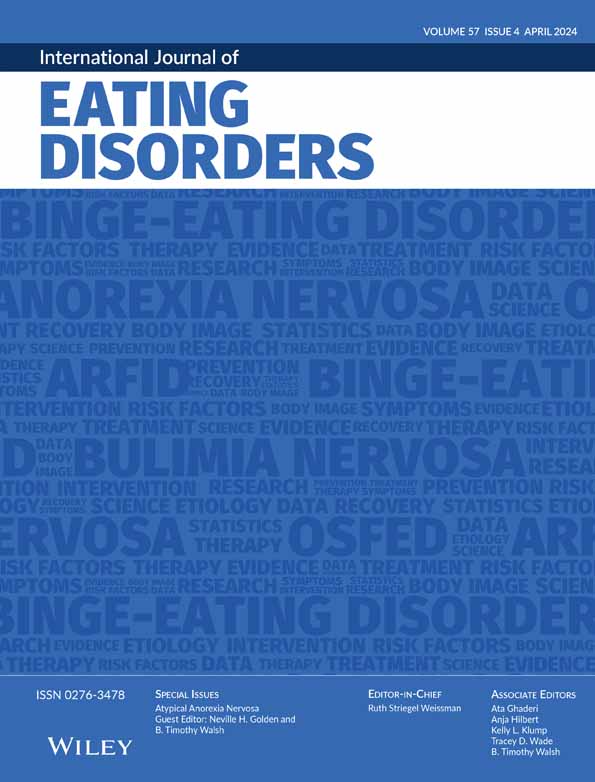Differentiating anorexia nervosa and atypical anorexia nervosa with absolute weight cut-offs results in a skewed distribution for premorbid weight among youth
Abstract
Objective
Anorexia nervosa (AN) and atypical AN are conceptualized as distinct illnesses, despite similar characteristics and sequelae. Whereas DSM-5 differentiates youth with AN and atypical AN by the presence of clinical ‘underweight’ (i.e., 5th BMI percentile for age-and-sex (BMI%)), we hypothesized that using this weight cut-off to discern diagnoses creates a skewed distribution for premorbid weight.
Method
Participants included hospitalized youth with AN (n = 165, 43.1%) and atypical AN (n = 218, 56.9%). Frequency analyses and chi-square tests assessed the distribution of premorbid BMI z-scores (BMIz) for diagnosis. Non-parametric Spearman correlations and Stepwise Linear regressions examined relationships between premorbid BMIz, admission BMIz, and weight loss in kg.
Results
Premorbid BMIz distributions differed significantly for diagnosis (p < .001), with an underrepresentation of ‘overweight/obesity’ (i.e., BMI% ≥ 85th) in AN. Despite commensurate weight loss in AN and atypical AN, patients with premorbid ‘overweight/obesity’ were 8.31 times more likely to have atypical AN than patients with premorbid BMI% < 85th. Premorbid BMIz explained 57% and 39% of the variance in admission BMIz and weight loss, respectively.
Discussion
Findings support a homogenous model of AN and atypical AN, with weight loss predicted by premorbid BMI in both illnesses. Accordingly, premorbid BMI and weight loss (versus presenting BMI) may better denote the presence of an AN-like phenotype across the weight spectrum. Findings also suggest that differentiating diagnoses with BMI% < 5th requires that youth with higher BMIs lose disproportionately more weight for an AN diagnosis. This is problematic given unique treatment barriers experienced in atypical AN.
Public significance
Anorexia nervosa (AN) and atypical AN are considered distinct conditions in youth, with differential diagnosis hinging upon a presenting weight status of ‘underweight’ (i.e., BMI percentile for age-and-sex (BMI%) < 5th). In our study, youth with premorbid ‘overweight/obesity’ (BMI% ≥ 85th) disproportionately remained above this threshold, despite similar weight loss. Coupled with prior evidence for commensurate characteristics and sequelae in both diagnoses, we propose that DSM-5 differentiation of AN and atypical AN inadvertently reinforces weight stigma and may contribute to treatment disparities in atypical AN.
CONFLICT OF INTEREST STATEMENT
Abigail Matthews, Jessica Lin, Grace Jhe, Leslie Sim, and Triinu Peters have no conflicts of interest to disclose. Johannes Hebebrand has received speech honoraria from Novo Nordisk and Amryt Pharmaceuticals in the past 3 years. He is listed as an inventor in three patent applications of the University of Duisburg-Essen for the use of leptin analogues for treatment of anorexia nervosa and depression.
Open Research
DATA AVAILABILITY STATEMENT
The data that support the findings of this study are available from the corresponding author upon reasonable request.




